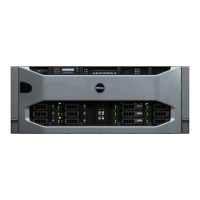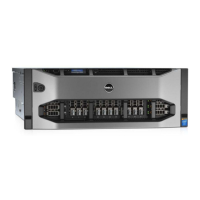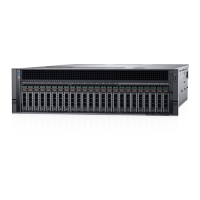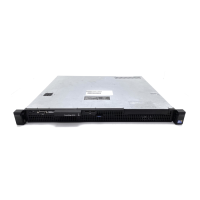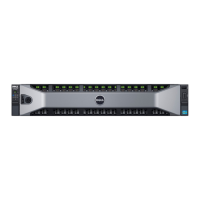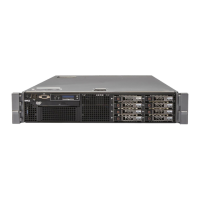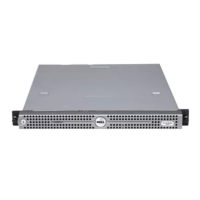Do you have a question about the Dell PowerEdge R930 and is the answer not in the manual?
Explains diagnostic indicators for hardware status.
Explains hard drive LED status patterns and conditions.
Details SSD LED status patterns for device states.
Explains NIC link and activity indicator status.
Explains iDRAC Direct LED activity during configuration.
Describes PSU status indicators and their meanings.
Explains IDSDM LED status codes.
Details supported memory module types and capacities.
Details supported hard drive and SSD options.
Provides steps for setting up the system.
Explains iDRAC's purpose and configuration.
Details methods for configuring the iDRAC IP address.
Lists resources for installing the OS.
Explains methods for downloading firmware and drivers.
Explains configuring BIOS, iDRAC, and device settings.
Details options within the System Setup Main Menu.
Describes editing BIOS functions like boot order and passwords.
Details options within the System BIOS Settings screen.
Explains setting boot mode and order.
Explains BIOS vs UEFI boot modes.
Covers setting passwords and disabling the power button.
Details options for system security settings.
Guides on creating system and setup passwords.
Covers viewing memory settings and functions.
Details processor settings like virtualization and prefetcher.
Covers viewing SATA settings and enabling RAID.
Details settings for integrated devices like video and USB.
Covers system performance settings like power management.
Explains configuring iDRAC parameters via UEFI.
Explains LC capabilities for system deployment and maintenance.
Details Lifecycle Controller for embedded system management.
Covers selecting boot options and diagnostic utilities.
Provides critical safety warnings for component handling.
Outlines prerequisites and steps before internal system work.
Outlines steps and prerequisites after internal system work.
Explains the system cover's function and removal.
Provides steps to remove the system cover.
Provides steps to install the system cover.
Details system memory support and specifications.
Covers removing and installing memory riser blanks.
Emphasizes safety precautions before troubleshooting.
Guides on resolving system startup failures.
Guides on troubleshooting systems exposed to moisture.
Guides on troubleshooting systems with physical damage.
Guides on troubleshooting system battery issues.
Guides on troubleshooting power supply unit (PSU) issues.
Guides on troubleshooting system cooling issues.
Guides on troubleshooting cooling fan issues.
Guides on troubleshooting system memory issues.
Guides on troubleshooting hard drive issues.
Guides on troubleshooting storage controller issues.
Guides on troubleshooting expansion card issues.
Guides on troubleshooting processor issues.
Details Dell Embedded System Diagnostics (ePSA).
Guides on disabling forgotten system/setup passwords.
Explains diagnostic indicators for hardware status.
Explains hard drive LED status patterns and conditions.
Details SSD LED status patterns for device states.
Explains NIC link and activity indicator status.
Explains iDRAC Direct LED activity during configuration.
Describes PSU status indicators and their meanings.
Explains IDSDM LED status codes.
Details supported memory module types and capacities.
Details supported hard drive and SSD options.
Provides steps for setting up the system.
Explains iDRAC's purpose and configuration.
Details methods for configuring the iDRAC IP address.
Lists resources for installing the OS.
Explains methods for downloading firmware and drivers.
Explains configuring BIOS, iDRAC, and device settings.
Details options within the System Setup Main Menu.
Describes editing BIOS functions like boot order and passwords.
Details options within the System BIOS Settings screen.
Explains setting boot mode and order.
Explains BIOS vs UEFI boot modes.
Covers setting passwords and disabling the power button.
Details options for system security settings.
Guides on creating system and setup passwords.
Covers viewing memory settings and functions.
Details processor settings like virtualization and prefetcher.
Covers viewing SATA settings and enabling RAID.
Details settings for integrated devices like video and USB.
Covers system performance settings like power management.
Explains configuring iDRAC parameters via UEFI.
Explains LC capabilities for system deployment and maintenance.
Details Lifecycle Controller for embedded system management.
Covers selecting boot options and diagnostic utilities.
Provides critical safety warnings for component handling.
Outlines prerequisites and steps before internal system work.
Outlines steps and prerequisites after internal system work.
Explains the system cover's function and removal.
Provides steps to remove the system cover.
Provides steps to install the system cover.
Details system memory support and specifications.
Covers removing and installing memory riser blanks.
Emphasizes safety precautions before troubleshooting.
Guides on resolving system startup failures.
Guides on troubleshooting systems exposed to moisture.
Guides on troubleshooting systems with physical damage.
Guides on troubleshooting system battery issues.
Guides on troubleshooting power supply unit (PSU) issues.
Guides on troubleshooting system cooling issues.
Guides on troubleshooting cooling fan issues.
Guides on troubleshooting system memory issues.
Guides on troubleshooting hard drive issues.
Guides on troubleshooting storage controller issues.
Guides on troubleshooting expansion card issues.
Guides on troubleshooting processor issues.
Details Dell Embedded System Diagnostics (ePSA).
Guides on disabling forgotten system/setup passwords.
| Tcase | 70 °C |
|---|---|
| Bus type | QPI |
| Stepping | E0 |
| FSB Parity | No |
| Scalability | S4S |
| Processor code | SR224 |
| Processor cache | 25 MB |
| Processor cores | 10 |
| Processor model | E7-4820V3 |
| System bus rate | 6.4 GT/s |
| Processor series | Intel Xeon E7-4800 v3 |
| Processor socket | LGA 2011 (Socket R) |
| Processor threads | 20 |
| Processor codename | Haswell |
| Motherboard chipset | Intel® C602J |
| Number of QPI links | 3 |
| Processor frequency | 1.9 GHz |
| Processor cache type | Last Level Cache |
| Processor lithography | 22 nm |
| Processor manufacturer | Intel |
| Processor package size | 52 x 45 mm |
| Processor front side bus | - MHz |
| Processor operating modes | 64-bit |
| PCI Express configurations | x4, x8, x16 |
| Supported instruction sets | AVX 2.0 |
| Thermal Design Power (TDP) | 115 W |
| Compatible processor series | Intel® Xeon® |
| Number of processors installed | 2 |
| Maximum number of SMP processors | 4 |
| Maximum number of PCI Express lanes | 32 |
| Memory types supported by processor | DDR4-SDRAM, DDR3-SDRAM |
| Memory channels supported by processor | Quad |
| Memory clock speeds supported by processor | 1333, 1600, 1866, 1066 MHz |
| Memory bandwidth supported by processor (max) | 102 GB/s |
| Maximum internal memory supported by processor | 1536 GB |
| Intelligent Platform Management Interface (IPMI) support | Yes |
| HDD size | 2.5 \ |
| HDD speed | 10000 RPM |
| RAID levels | 0, 1, 5, 6, 10, 50, 60 |
| HDD interface | Serial Attached SCSI (SAS) |
| Optical drive type | DVD±RW |
| Total storage capacity | 300 GB |
| Maximum storage capacity | - TB |
| Number of HDDs installed | 1 |
| Supported storage drive interfaces | Serial ATA III |
| Memory slots | 96 |
| Internal memory | 64 GB |
| Memory clock speed | 1866 MHz |
| Internal memory type | DDR4-SDRAM |
| Maximum internal memory | 3072 GB |
| Graphics card | G200 |
| Graphics card family | Matrox |
| LAN controller | Broadcom 5720 |
| Cabling technology | 10/100/1000Base-T(X) |
| Ethernet interface type | Gigabit Ethernet |
| USB 2.0 ports quantity | USB 2.0 ports have a data transmission speed of 480 Mbps, and are backwards compatible with USB 1.1 ports. You can connect all kinds of peripheral devices to them. |
| USB 3.2 Gen 1 (3.1 Gen 1) Type-A ports quantity | 0 |
| Performance management | iDRAC8 Enterprise |
| Compatible operating systems | Microsoft Windows Server 2008 R2\\r Microsoft Windows Server 2012\\r Microsoft Windows Server 2012 R2\\r Novell SUSE Linux Enterprise Server\\r Red Hat Enterprise Linux\\r VMware ESX |
| Chassis type | Rack (4U) |
| Power supply | 1100 W |
| Processor ARK ID | 84677 |
| Intel Secure Key Technology version | 1.00 |
| Intel Instruction Replay Technology version | 0.00 |
| PCI Express slots version | 3.0 |
| On-board graphics card model | Not available |
| Depth | 802.3 mm |
|---|---|
| Width | 482.4 mm |
| Height | 172.6 mm |
| Weight | 23800 g |
